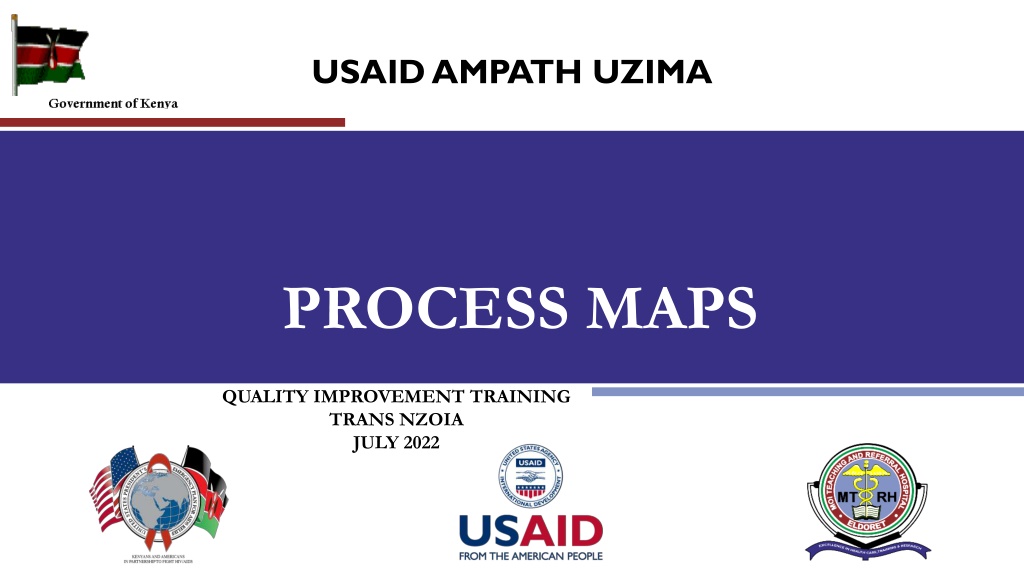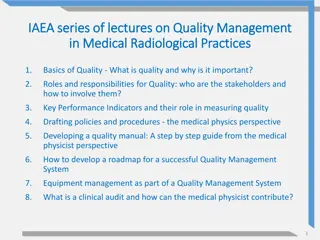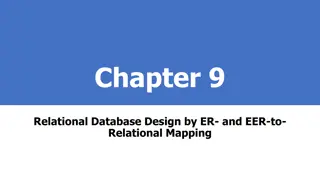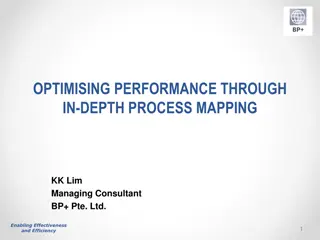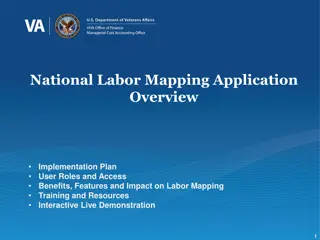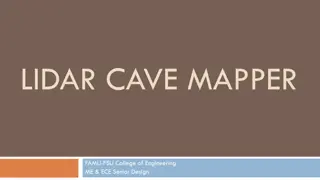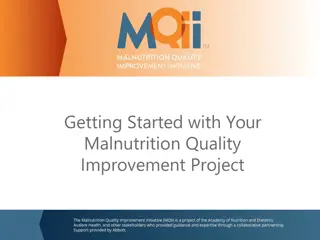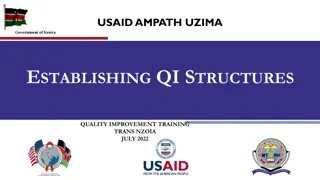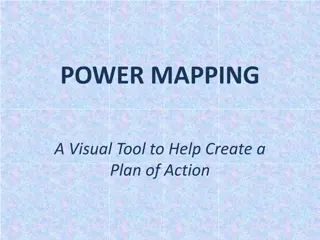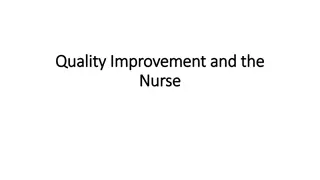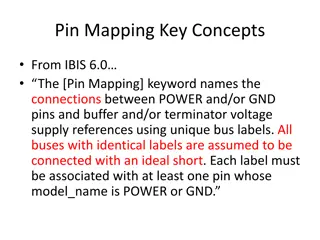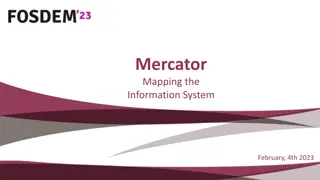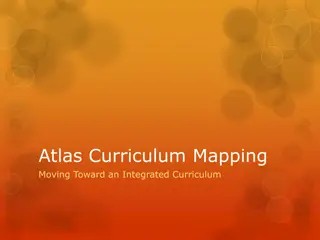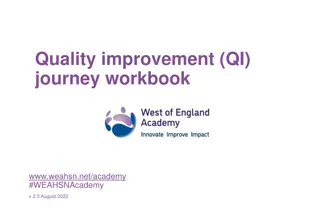Understanding Process Mapping for Healthcare Quality Improvement Training
Explore the training session on process mapping for healthcare quality improvement conducted by USAID.AMPATH.Uzima. Learn to apply process mapping to identify root causes of poor quality in the healthcare system, understand the significance of root cause definition, and utilize process map symbols. Delve into different types of process maps and their applications to enhance healthcare processes effectively.
Download Presentation

Please find below an Image/Link to download the presentation.
The content on the website is provided AS IS for your information and personal use only. It may not be sold, licensed, or shared on other websites without obtaining consent from the author. Download presentation by click this link. If you encounter any issues during the download, it is possible that the publisher has removed the file from their server.
E N D
Presentation Transcript
USAID AMPATH UZIMA PROCESS MAPS QUALITY IMPROVEMENT TRAINING TRANS NZOIA JULY 2022
LEARNING OBJECTIVES By the end of this session, participants will be able to: Apply Process Mapping exercise to identify a root causes of poor quality within the healthcare system. USAID AMPATH Uzima
OUTLINE QI Tool: Process Map 5 Whys Energizer Group Work USAID AMPATH Uzima
ROOT CAUSE DEFINITION The most basic cause (or causes) that can reasonably be identified that management has control to fix and, when fixed, will prevent (or significantly reduce the likelihood of) the problem s recurrence. USAID AMPATH Uzima - Paradies (2005)
PROCESS MAPS Do you agree with this statement? If you can t describe what you are doing as a process, you don t know what you are doing. USAID AMPATH Uzima - W.E. Deming
QI TOOL: PROCESS MAP A picture of how a process works-A picture that shows how things get done! Also called a flow chart Provides teams with opportunities to learn the different steps in a process where many people are involved Often, team members do not actually agree on the steps Identifies root causes: Bottlenecks, duplicative steps, wasteful steps, disagreement about steps, rework due to errors, sources of delays, role confusion USAID AMPATH Uzima
PROCESS MAP SYMBOLS Rectangular S Documentation points Ovals Start & end of process Clouds Unclear steps Rectangles Action steps Arrows Flow lines Diamonds Decision points Smooth edged rectangles Delays in a process USAID AMPATH Uzima
TYPES OF PROCESS MAPS There are several types of process Maps: Detailed process map Top-down proces map High level proces map Deplyoment process map (Cross functional) USAID AMPATH Uzima
TYPES OF PROCESS MAPS I. (High level process Map) USAID AMPATH Uzima Immunization process at the health facility
TYPES OF PROCESS MAPS II. (Detailed process map) Detailed process of the care provided to a male STI patient source; FHI360 QI handbook USAID AMPATH Uzima
III. (Deployement process Map) USAID AMPATH Uzima Immunization process at the health facility
(Top-down process Map) STEP 2 STEP 3 STEP 1 2a 3a 1a 2b 3b 1b 2c 3c 1c 2d 3d 2e USAID AMPATH Uzima
PROCESS MAPS: STEPS 1. Identify start and end points 2. Agree on mapping method and symbols: Start with steps in the process that s actually happening Start with steps in the ideal process, and compare to what s actually happening 3. Ask questions to facilitate Process Map development: What happens next? Who is responsible? How long does it take? 4. Consider each step from a different perspective, like that of the client or consumer USAID AMPATH Uzima
EXAMPLE: CLIENT REGISTRATION PROCESS Patient arrives at front desk Start/End Nurse asks for patient name & searches for his/her file Decision Is the patient in the system? Ask the patient to complete registration No Yes Action Ask the patient to wait in the waiting area USAID AMPATH Uzima
EXAMPLE: DELIVERY CARE(BEFORE IMPROVEMENT) Routine care Mother- to-be arrives NO PPH? Immediate postpartum care YES Discharge procedure Reception & orientation Stabiliz ation? Delivery care Evaluation & examination Discharge YES Examination in labor room Monitoring of labor Referral - Application of Collaborative Improvement in Developing Countries: Practical Orientation Guide USAID AMPATH Uzima
EXAMPLE: THE PIZZA PLACE(CURRENT STATE) USAID AMPATH Uzima - North Carolina Center for Public Health Quality
EXAMPLE: THE PIZZA PLACE(IDEAL STATE) 17 USAID AMPATH Uzima - North Carolina Center for Public Health Quality
PROCESS MAP: ANALYSIS Utilize the Whys Technique (Why is it done? Why its done this way? By this person? At this place and time?) Are there any disagreements? Are there any duplications? What is the time between steps? Are the steps in the right order? Is the right person doing the job? USAID AMPATH Uzima
EXAMPLE: INFANT ART INITIATIONHOW WOULDYOUHELPTHETEAM ANALYZETHIS PROCESS? Follow up again Nurse receive HIV + result Initiate on ART Nurse obtains client file from the storage area Document on EID Register Document on EID Register Ask caregiver to bring infant immediately to clinic Contact info available? NO YES YES NO Nurse texts caregiver to notify that client needs to come to clinic immediately Document on EID register Follow up Call? When? Does the care giver bring the infant back to the facility ? USAID AMPATH Uzima
PROCESS MAP SUMMARY Strengths Allows multidisciplinary teams to gain a deep understanding of how a process actually works Weaknesses If the right people aren t engaged from the start, some process steps may be unclear or missed Facilitates ownership among staff Great tool to visualize a process Creates a shared mental model from which to develop change ideas During meetings, some team members may get stuck on mapping the ideal process rather than the actual process The process may need to be repeated multiple times USAID AMPATH Uzima
GROUP WORK Teams will construct a process map from the case study on QI reference guide.. (60 minutes) USAID AMPATH Uzima
USAID AMPATH UZIMA THANK YOU info@ampathkenya.org | www.ampathkenya.org | @ampathkenya
